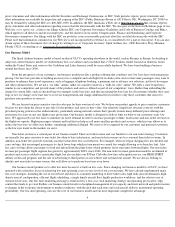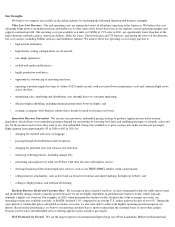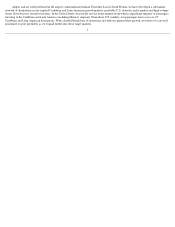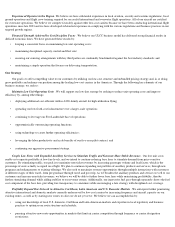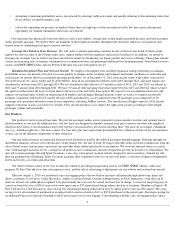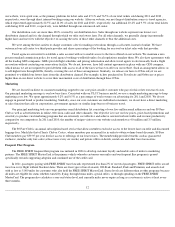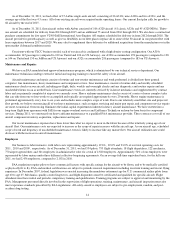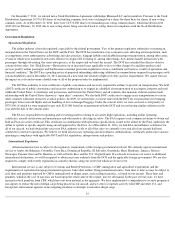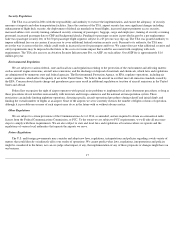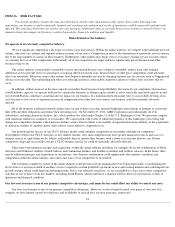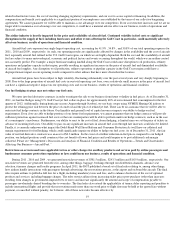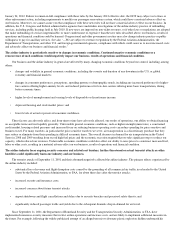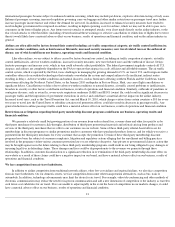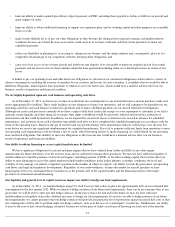Spirit Airlines 2011 Annual Report Download - page 17
Download and view the complete annual report
Please find page 17 of the 2011 Spirit Airlines annual report below. You can navigate through the pages in the report by either clicking on the pages listed below, or by using the keyword search tool below to find specific information within the annual report.
As of December 31, 2011, we had a fleet of 37 Airbus single-aisle aircraft, consisting of 26 A319s, nine A320s and two A321s, and the
average age of the fleet was 4.5 years. All of our existing aircraft were acquired under operating leases. Our current fleet plan calls for growth to
68 aircraft by the end of 2015.
As of December 31, 2011, firm aircraft orders with Airbus consisted of 106 A320 aircraft (61 classic A320s and 45 A320 NEOs). Thirty-
one aircraft are scheduled for delivery from 2012 through 2015 and an additional 75 aircraft from 2016 through 2021. We also have a contractual
purchase commitment for five spare V2500 IAE International Aero Engines AG engines scheduled for delivery in from 2012 through 2018. The
aircraft provide for growth capacity as well as give us flexibility in our fleet plan to replace all or some of the 30 aircraft in our present fleet with
lease expirations between 2017 and 2020. We may elect to supplement these deliveries by additional acquisitions from the manufacturer or in the
open market if demand conditions merit.
Consistent with our ULCC business model, each of our aircraft is configured with a high density seating configuration. Our A319s
accommodate 145 passengers (compared to 120 on United and 124 on US Airways), our A320s accommodate 178 passengers (compared to 138
or 144 on United and 150 on JetBlue and US Airways) and our A321s accommodate 218 passengers (compared to 183 on US Airways).
Maintenance and Repairs
We have an FAA mandated and approved maintenance program, which is administered by our technical services department. Our
maintenance technicians undergo extensive initial and ongoing training to ensure the safety of our aircraft.
Aircraft maintenance and repair consists of routine and non-routine maintenance and work performed is divided into three general
categories: line maintenance, heavy maintenance and component service. Line maintenance consists of routine daily and weekly scheduled
maintenance checks on our aircraft, including pre-flight, daily, weekly and overnight checks and any diagnostics and routine repairs and any
unscheduled items on an as needed basis. Line maintenance events are currently serviced by in-house mechanics and supplemented by contract
labor and are primarily completed at airports we currently serve. Heavy airframe maintenance checks consist of a series of more complex tasks
that can take from one to four weeks to accomplish and typically are required approximately every 20 months. Heavy engine maintenance is
performed approximately every four to six years and includes more complex scope of work. Due to our relatively small fleet size and projected
fleet growth, we believe outsourcing all of our heavy maintenance, such as engine servicing and major part repair, and component service repairs
are more economical. Outsourcing eliminates the initial capital requirements inherent in heavy aircraft maintenance. We have entered into a
long-term flight hour agreement with IAE for our engine overhaul services and Lufthansa Technik on an hour-by-hour basis for component
services. During 2011, we outsourced our heavy airframe maintenance to a qualified FAA maintenance provider. These contracts cover all of our
aircraft component inventory acquisition, replacement and repairs.
Our recent maintenance expenses have been lower than what we expect to incur in the future because of the relatively young age of our
aircraft fleet. Our maintenance costs are expected to increase as the scope of repair increases with the aircraft age. As our aircraft age, scheduled
scope of work and frequency of unscheduled maintenance events is likely to increase like any mature fleet. Our aircraft utilization rate could
decrease with the increase in aircraft maintenance.
Employees
Our business is labor intensive, with labor costs representing approximately 19.6% , 22.0% and 23.0% of our total operating costs for
2011 , 2010 and 2009 , respectively. As of December 31, 2011, we had 534 pilots, 795 flight attendants, 18 flight dispatchers, 122 mechanics,
770 airport agents/other, and 341 employees in administrative roles for a total of 2,580 employees. Approximately 52% of our employees were
represented by labor unions under three different collective-bargaining agreements. On an average full-time equivalent basis, for the full year
2011, we had 2,456 employees, compared to 2,192 in 2010.
FAA regulations require pilots to have commercial licenses with specific ratings for the aircraft to be flown, and to be medically certified
as physically fit to fly. FAA and medical certifications are subject to periodic renewal requirements including recurrent training and recent flying
experience. In December 2007, federal legislation was enacted increasing the mandatory retirement age for U.S. commercial airline pilots from
age 60 to age 65. Mechanics, quality-control inspectors, and flight dispatchers must be certificated and qualified for specific aircraft. Flight
attendants must have initial and periodic competency training and qualification. Training programs are subject to approval and monitoring by the
FAA. Management personnel directly involved in the supervision of flight operations, training, maintenance, and aircraft inspection must also
meet experience standards prescribed by FAA regulations. All safety-sensitive employees are subject to pre-employment, random, and post-
accident drug testing.
14


